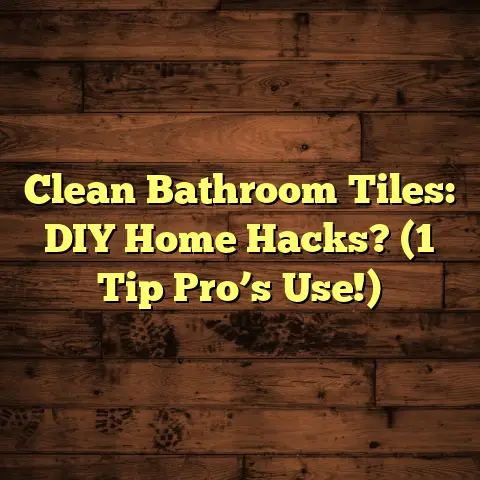Pet Friendly Carpet Worth It? (7 Cost Factors!)
I’ve seen it all in my years as a flooring contractor. Picture this: A family loves their Golden Retriever, Max, and their curious cat, Whiskers. Their house is full of love, laughter, and… carpet stains. Sound familiar?
They’re facing a dilemma: replace the worn-out carpet. But this time, they’re wondering if a pet-friendly option is the way to go. Is it just marketing hype, or a real solution?
That’s what we’re diving into. We’ll explore seven crucial cost factors to help you decide if pet-friendly carpet is a smart investment for YOUR home.
1. Understanding Pet-Friendly Carpet
So, what exactly is pet-friendly carpet? It’s not just a label. It’s about materials, construction, and features designed to withstand the unique challenges pets bring.
Think: accidents, shedding, and the occasional zoomies-induced wear and tear.
Materials Matter:
-
Nylon: This is a champion for durability. It bounces back from heavy traffic and resists stains well.
-
Polyester (especially PET Polyester): Often made from recycled materials, it’s stain-resistant and budget-friendly. However, it might not be as resilient as nylon in high-traffic areas.
-
Olefin (Polypropylene): Resistant to moisture and mold, making it a good choice for basements or areas prone to pet accidents. It’s less durable than nylon, though.
Durability and Stain Resistance:
These are the cornerstones of pet-friendly carpet. We’re talking about fibers that resist absorbing liquids, preventing stains and odors from setting in. Also, carpets that can handle the daily pounding of paws.
2. Cost Factor 1: Initial Purchase Price
Let’s get down to brass tacks: how much does this stuff cost? Pet-friendly carpet generally comes with a higher price tag than traditional options.
Price Range:
Expect to pay anywhere from 20% to 50% more for pet-friendly carpet, depending on the material and features. You might find traditional carpets at $2-$4 per square foot, while pet-friendly options could range from $3-$6 (or even higher) per square foot.
What Drives the Price?
-
Brand: Certain brands known for pet-friendly innovations (like LifeProof at Home Depot) often command a premium.
-
Material: As mentioned, nylon tends to be pricier than polyester.
-
Technology: Stain-resistant treatments, waterproof backings, and advanced fiber construction all add to the cost.
Examples:
-
LifeProof (Home Depot): Known for its stain and water resistance, prices generally range from $3.50 to $5.50 per square foot.
-
Shaw Floors (Pet Perfect): Offers a variety of styles with enhanced stain and soil protection. Expect to pay around $4 to $7 per square foot.
-
Mohawk (SmartStrand Forever Clean): Features built-in stain resistance that won’t wear off. Prices typically fall in the $4.50 to $8 range.
3. Cost Factor 2: Installation Expenses
Don’t forget about installation! This can significantly impact your overall cost.
Professional vs. DIY:
-
Professional Installation: Expect to pay $1 to $3 per square foot for professional installation. This includes removing the old carpet, preparing the subfloor, and installing the new carpet.
-
DIY: You’ll save on labor costs, but you’ll need to rent tools (like a carpet stretcher) and invest your time. Plus, improper installation can void warranties.
Installation Complexity:
Some pet-friendly carpets, particularly those with waterproof backings, can be more challenging to install. It’s crucial to ensure a proper seal to prevent moisture from seeping through.
Hidden Costs:
-
Padding: Upgrading your carpet padding is almost always a good idea. A quality pet-friendly pad can add $0.50 to $1.50 per square foot.
-
Subfloor Preparation: If your subfloor is uneven or damaged, you’ll need to repair it before installing the new carpet. This can add unexpected costs.
4. Cost Factor 3: Maintenance and Cleaning
Let’s be honest, pet messes are inevitable. The key is how easily you can clean them up.
Maintenance Requirements:
Pet-friendly carpets generally require regular vacuuming (at least twice a week) to remove pet hair and dander. Promptly cleaning up accidents is crucial to prevent stains and odors from setting in.
Cleaning Costs:
-
Cleaning Supplies: Invest in a good quality pet stain and odor remover. Expect to spend $10 to $20 per bottle.
-
Professional Cleaning: Professional carpet cleaning can cost $50 to $150 per room, depending on the size and the severity of the stains. You might need to do this 1-2 times per year.
Easy to Clean = Cost Savings:
The easier a carpet is to clean, the less you’ll spend on cleaning supplies and professional services in the long run. Look for carpets with built-in stain resistance or waterproof backings.
5. Cost Factor 4: Longevity and Durability
How long will your new carpet last? This is a HUGE factor in determining its overall value.
Lifespan Comparison:
-
Traditional Carpet: Typically lasts 5-10 years, depending on the quality and traffic.
-
Pet-Friendly Carpet: Can last 10-15 years (or even longer) with proper care, thanks to its enhanced durability and stain resistance.
Durability = Long-Term Savings:
While pet-friendly carpet has a higher upfront cost, its longer lifespan can save you money in the long run by delaying the need for replacement.
Wear and Tear Rates:
According to the Carpet and Rug Institute (CRI), carpets with higher density ratings and tighter loops tend to resist wear and tear better. Look for carpets with a density rating of 5,000 or higher for optimal durability.
6. Cost Factor 5: Resale Value of the Home
Thinking of selling your home down the road? Pet-friendly carpet can be a selling point.
Buyer Perceptions:
Many buyers, especially those with pets or allergies, view pet-friendly flooring as a major plus. It signals that the home is clean, well-maintained, and suitable for their lifestyle.
Market Trends:
Pet ownership is on the rise, and so is the demand for pet-friendly features in homes. Highlighting these features in your listing can attract more potential buyers and potentially increase your home’s value.
Potential Increase in Value:
While it’s difficult to put an exact number on it, upgrading to pet-friendly carpet could potentially increase your home’s resale value by 1-3%, depending on the market and the overall condition of your home.
7. Cost Factor 6: Health and Comfort Considerations
Let’s not forget about the health and comfort of your family (including your furry friends!).
Health Implications:
Some carpet materials can trap allergens and release volatile organic compounds (VOCs), which can trigger allergies and respiratory problems.
Hypoallergenic Options:
Look for carpets made from hypoallergenic materials like nylon or those with low-VOC certifications (like Green Label Plus).
Comfort Level:
Pet-friendly carpets are often designed to be soft and comfortable underfoot, providing a cozy space for both pets and humans to relax.
Avoiding Health Costs:
Choosing the right carpet can help minimize allergy symptoms and respiratory issues, potentially reducing healthcare costs in the long run.
8. Cost Factor 7: Environmental Impact and Sustainability
Are you eco-conscious? Sustainable carpet options are becoming increasingly popular.
Eco-Friendly Options:
Look for carpets made from recycled materials (like PET polyester) or those with sustainable certifications (like Cradle to Cradle).
Long-Term Cost Benefits:
Sustainable carpets often have a longer lifespan and require less maintenance, reducing their overall environmental footprint and saving you money in the long run.
Influence on Purchasing Decisions:
For many homeowners, environmental considerations play a significant role in their purchasing decisions. Choosing a sustainable carpet can align with your values and contribute to a healthier planet.
Conclusion: Is Pet-Friendly Carpet Worth It?
So, is pet-friendly carpet worth the investment? It depends! Let’s recap those seven cost factors:
- Initial Purchase Price: Higher upfront cost.
- Installation Expenses: Similar to traditional carpet, but waterproof options may require extra care.
- Maintenance and Cleaning: Easier to clean, potentially saving you money in the long run.
- Longevity and Durability: Longer lifespan than traditional carpet.
- Resale Value of the Home: Can increase your home’s appeal to potential buyers.
- Health and Comfort Considerations: Hypoallergenic options available.
- Environmental Impact and Sustainability: Eco-friendly choices exist.
Think about your lifestyle, your pets’ behavior, and your budget. If you’re tired of constantly battling stains and odors, pet-friendly carpet might be a worthwhile investment.
Weigh the pros and cons, do your research, and choose the option that best suits your unique needs. Good luck with your flooring project!





